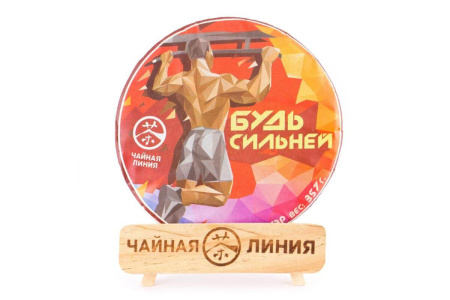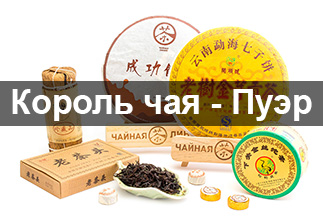Title: " Be Stronger "
Raw material production date: 2018
Pressing date: 2019
Claimed weight: 357 g.
Shape: pancake (bincha).
Brand: " Tea line ".
Area where raw materials grow: Menghai region (勐海县, měnghǎi xiàn), Xishuangbanna-Dai Autonomous Prefecture (西双版纳傣族自治州), Yunnan Province (云南省, yúnnán shěng), China.
A truly original and unique signature shu puerh cake "Be Stronger". Made from blended raw materials from tea sites in the Menghai region of the Xishuangbanna Dai Autonomous Prefecture, which is located in the south of Yunnan Province. It includes the counties of Jinghong, Menghai and Mengla. Xishuangbanna is the main county where most puerhs are produced in China.
For the shu puerh "Be Stronger" tea leaves of the " da ye zhong " (大叶种, dàyězhǒng) variety were used, which characterizes them as leaves with a large leaf blade. The tea raw materials in the cake look diverse, with a large number of hairy buds and leaves. In the split, a delicate prune aroma is felt. When brewing, the aroma of walnut is added to it.
Limited edition tea.
The signature pancake has a rich and velvety, chocolate-nutty aroma with hints of spices. Washed pu-erh reveals a warm, sweetish hue with notes of cocoa beans, homemade biscuit and sweet spices.
The taste of the brewed tea is delicate, chocolate-nutty, with spicy notes and touches of grated cocoa. The body of the tea is delicate, thick and dense. The tea easily rolls down the throat, enveloping the entire oral cavity. This puerh withstands 8 full infusions. Gradually, the taste palette changes towards spicy-woody notes with shades of dark chocolate.
The aftertaste is chocolate-berry, rich and balanced. The infusion is clear, dark chestnut in color with a red-brown tint.
Pu'er is best enjoyed in a thick-walled Yixing teapot or a porcelain gaiwan.
Tea Qi is strong and straightforward. It actively manifests itself after the first cup. Tea tones well, sobers up and concentrates attention, balances, gives a feeling of comfort and sets the right mood.
Shu Puer 2019 "Be Stronger" by the Tea Line brand is a wonderful tea made from high-quality raw materials collected in the highlands, with a memorable taste and a strong tea effect. It is suitable for leisurely tea drinking in the company of close friends on a day off, or will be an excellent gift for a puer lover.
|
Country
|
China |
|
District
|
Xishuangbanna Dai Autonomous Prefecture |
|
Provinces
|
Yunnan (云南) |
|
Manufacturer
|
Чайная Линия |
|
Raw material production date
|
2020 |
|
Year of pressing
|
2021 |
|
Pressing form
|
Bing Cha (Cake Tea) |
|
Declared weight, g
|
357 |
- Комментарии
- Вконтакте
Pu-erh is one of the most unique types of tea, which only gets better with age. Many people, when they first encounter this tea, wondered: why is pu-erh more often found in pressed form (cakes, bricks, tochas), and not in loose form? The reasons for this are related to both history and the practical aspects of storing and fermenting tea. Despite modern technologies that allow the production of loose pu-erh, the shape of pressed cakes remains unchanged. And pu-erh is more often found on sale in pressed form, for example, in the form of cakes or bricks, and loose pu-erh is less common. We will talk about the reasons for pressing pu-erh into cakes in this article.
Puer is a unique Chinese tea that is distinguished by its depth of taste, complexity of aromas and versatility of aftertaste. Its taste characteristics are formed under the influence of many factors, from growing conditions to the brewing method. Let's look at the main ones.
Over time, some consumers who are part of the country's "tea elite" discover mainland Chinese tea. And only a few get acquainted with Taiwanese varieties. The path of a tea person is usually long and thorny, but ultimately it leads to the King of Teas - puer. But not everyone is able to go all the way from ordinary teas to puer and appreciate its qualities.
The tea ceremony occupies a special place in the centuries-old Eastern tradition. And although the essence of this phenomenon remains constant, the nature and external manifestations of the tea ceremony in different nations have their own national characteristics. In each Chinese province, the tea ceremony and the tea used in it are varied: for example, residents of the southern provinces prefer green tea, and residents of the northern provinces - red tea, in Fujian province they more often use Oolong tea, and in Yunnan province Puer tea is widely known.


























































































